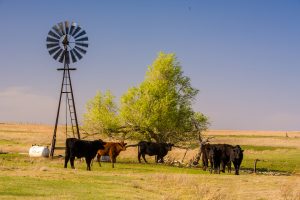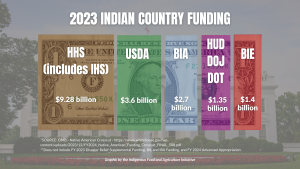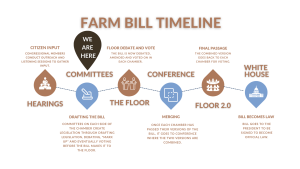Oklahoma Bar Journal
Farm Bill Implications in Indian Country
By Carly Griffith Hotvedt, Kelli Case and Mallory Moore

Bob | #362374139 | stock.adobe.com
The farm bill is one of the largest pieces of omnibus legislation passed by Congress. Farm bills are generally authorized for five years and permit programmatic and funding support for food and agriculture systems in the United States.[1] The Agricultural Adjustment Act of 1933 (AAA), now known as the first “farm bill,” passed in the wake of the Great Depression and was signed into law by President Franklin D. Roosevelt in order to address volatility in American agriculture markets.[2] The price volatility of agricultural commodities was predicated by an excess supply of some commodities and severe supply deficits of other crops and food products due in part to weather-related disasters and exacerbated due to poor production practices in conflict with good environmental and natural resources management.[3] However, this first farm bill did nothing to address agricultural cultivation and production practices that disrupted critical natural resources.[4] It also contained no provisions considering tribal agriculture, tribal producers or tribal lands.[5]
DEVELOPMENT OF TRIBAL AGRICULTURE AND FOOD SYSTEMS
Only in June 1924 were U.S.-born Native Americans uniformly granted American citizenship through the Indian Citizenship Act.[6] Nine years after the enactment of the Indian Citizenship Act, many Native Americans were not fully enfranchised under state law and were unable to vote, secure congressional representation or consideration, or uniformly participate in the American political process that would produce the AAA in 1933.[7] Further compounding issues of political access, tribal subjection to reservation and removal era policies had significantly disrupted tribal food and agriculture systems, resulting in separation from traditional food sources, burdensome influence over tribal production agriculture practices[8] and dependence on federal nutrition support.[9] Additionally, despite the congressional assertion of the encouragement of tribes to take up yeoman farming,[10] allotment policies in the early 1900s resulted in further divestment of tribal lands, creating a land ownership system not conducive to common tribal production agriculture practices.[11] Tribes were severely underrepresented and under-considered in farm bill titles until more recently.
While tribal nutrition programs – like the Food Distribution Program on Indian Reservations (colloquially known as “commods”)[12] – have existed since the 1970s,[13] consideration of production agriculture through the lens of tribal farmers and ranchers on tribal lands wasn’t realized until the 1990 Farm Bill.[14] Efforts to advocate for tribal farmers and ranchers consolidated after the 1980s farm crisis when the Intertribal Agriculture Council (IAC) was formed in 1987.[15] IAC recognized that tribes and tribal producers were frequently underserved by U.S. Department of Agriculture (USDA) programs, which are created and authorized through farm bill measures.[16] As a result of IAC’s efforts, the 1990 Farm Bill directed the secretary of Agriculture to consult with IAC in the development of reservation-based extension education programs intended to support local needs, including tribal production agriculture efforts.[17] In the ensuing years and subsequent farm bills, additional provisions have been added to further support tribal agriculture and food systems development.[18]
2018 FARM BILL
The most recent farm bill in 2018 reflects funding mechanisms that result in the USDA being the conduit for the second-largest federal funding transfer to Indian Country. Since 2018, between $3.6 billion to $4 billion is annually conveyed to tribes, tribal producers, intertribal organizations and other entities receiving and administering services and programming in support of Indian Country food and agriculture systems. (Graphic 1) Despite the funding amounts, there is currently no formal means of tribal participation and influence over USDA budget recommendations and allocations.[19] Therefore, legislative advocacy is critical for Indian Country to secure support for continued investment and stabilization of tribal food and agriculture systems. In 2017, IAC partnered with the National Congress of American Indians (NCAI), the Shakopee Mdewakanton Sioux Community (Shakopee) and the Indigenous Food and Agriculture Initiative (IFAI) as the policy and research partner to form the Native Farm Bill Coalition (NFBC) in the lead-up to the 2018 Farm Bill.[20] In contemplation of NFBC advocacy efforts, the Shakopee, through their Seeds of Native Health campaign, commissioned the IFAI to draft a report encapsulating Indian Country’s priorities for the 2018 Farm Bill. The IFAI hosted a series of roundtables to solicit input and feedback from tribes, tribal communities and tribal producers regarding the successes and challenges experienced in tribal food and agriculture efforts and any specific changes or additions to the 2018 Farm Bill.[21] The ensuing report, titled “Regaining Our Future,” formed the foundation of NFBC advocacy and engagement, ensuring that Indian Country’s priorities were uplifted to Congress and received due consideration in 2018 Farm Bill efforts.[22]
Due in large part to the efforts of the NFBC, the 2018 Farm Bill is the most tribally inclusive farm bill to date. Sixty-three tribally specific provisions expanded program access, improved tribal parity in treatment as a state or other authorized entity, increased technical assistance and outreach to Indian Country, improved tribal access to funding and increased sourcing and market opportunities for traditional and Native-produced foods. Additionally, for the first time, two opportunities for tribal self-governance were included in the farm bill: one in the Nutrition title and one in the Forestry title.
 In the Nutrition title, the 2018 Farm Bill authorized a pilot project permitting the USDA to contract with tribes to perform purchasing functions under its Food Distribution Program on Indian Reservations (FDPIR).[23] Typically, the USDA’s Agricultural Marketing Service (AMS) oversees procurement for the FDPIR and sources food products on a nationwide basis to supply the program. Nationwide sourcing creates significant difficulty in providing culturally and traditionally relevant and metabolically appropriate foods on a regional or even tribally specific basis for tribal program service recipients and in the ability of smaller-scale producers, like the majority of tribal farmers, to meet the volume demands of AMS procurement solicitations. The pilot, as introduced, begins to address these challenges. Participating tribes and intertribal organizations (ITOs) can choose to supplant items in the food package and procure alternatives themselves rather than relying on the AMS. Participating ITOs report resounding success. Tribes are incorporating traditional and cultural foods relevant to their tribe, seeing higher take rates of tribally procured foods among their participants and experiencing more engagement with the program. While not required by statute, tribes are by and large choosing to source from Indigenous and local producers, supporting economic development in their communities.[24] After two rounds of funding appropriations, 16 tribes and ITOs are participating in the pilot.[25]
In the Nutrition title, the 2018 Farm Bill authorized a pilot project permitting the USDA to contract with tribes to perform purchasing functions under its Food Distribution Program on Indian Reservations (FDPIR).[23] Typically, the USDA’s Agricultural Marketing Service (AMS) oversees procurement for the FDPIR and sources food products on a nationwide basis to supply the program. Nationwide sourcing creates significant difficulty in providing culturally and traditionally relevant and metabolically appropriate foods on a regional or even tribally specific basis for tribal program service recipients and in the ability of smaller-scale producers, like the majority of tribal farmers, to meet the volume demands of AMS procurement solicitations. The pilot, as introduced, begins to address these challenges. Participating tribes and intertribal organizations (ITOs) can choose to supplant items in the food package and procure alternatives themselves rather than relying on the AMS. Participating ITOs report resounding success. Tribes are incorporating traditional and cultural foods relevant to their tribe, seeing higher take rates of tribally procured foods among their participants and experiencing more engagement with the program. While not required by statute, tribes are by and large choosing to source from Indigenous and local producers, supporting economic development in their communities.[24] After two rounds of funding appropriations, 16 tribes and ITOs are participating in the pilot.[25]
Congress also conferred self-determination authority as a demonstration project under the Tribal Forest Protection Act (TFPA) for the first time in the 2018 Farm Bill.[26] The TFPA authorizes the secretaries of Agriculture and the Interior to give special consideration to tribally proposed projects on agency-managed land to protect Indian trust lands and resources from threats, such as fire, insects and disease.[27] Tribes may propose a TFPA project on agency-managed land that borders or is adjacent to trust land under certain enumerated circumstances.[28] Through the demonstration project, tribes can also contract to perform administrative, management and other functions of programs of the TFPA.[29] Participation in the forestry self-governance opportunity has been limited as, unlike the FDPIR pilot, there is no additional funding support available for tribes self-contracting to administer TFPA program functions.[30]
Under a typical five-year farm bill schedule, a new farm bill would be approved by Congress and signed into law before the expiration of the current farm bill.[31] However, the 2018 Farm Bill expired in September 2023.[32] While congressional agriculture committees have started the public hearing process,[33] issued solicitation from constituents and agriculture groups[34] and submitted marker bills for committee consideration, the process to draft and pass a new farm bill has stagnated.[35] (Graphic 2) While farm bills generally pass in a bipartisan fashion,[36] a divided Congress with a Democratic-led Senate and a Republican-led House with thin majority margins has encountered difficulty in coalescing around farm bill renewal due to a focus on other priority matters and broader legislative dysfunction.[37] Congress was able to pass a one-year extension (through September 2024) with continued authorization for 2018 Farm Bill programs prior to expiration, which was signed into law by President Biden in November 2023.[38] However, funding support for farm bill programs has only continued on shorter-term bases, requiring Congress to repeatedly revisit appropriations in early 2024.[39] In order to avoid a government shutdown impacting farm bill program operations generally, Congress will need to pass additional appropriations on or before those short-term funding expiration dates.
 In anticipation of the expiration of the 2018 Farm Bill, the NFBC renewed its efforts in 2022, again hosting a series of roundtables across Indian Country. The IFAI sourced the information shared by Native producers and tribal governments at these roundtables to draft an updated report on Indian Country’s farm bill priorities, titled “Gaining Ground.”[40] “Gaining Ground” reflects new and renewed priorities set by Indian Country for the next farm bill across all 12 titles.[41] Many of those priorities – including issues related to conservation, rural development, economic development, self-governance, access to credit and nutrition – are already gaining traction in Congress as evidenced by sponsored marker bills.[42] Marker bills are not intended to pass as stand-alone legislation. Instead, popular marker bills, in sum or part, are collected for inclusion in broader omnibus legislation, like the farm bill. Highlights of marker bills aligning with NFBC priorities are reflected below.[43] For the most up-to-date information about farm bill marker bills related to Indian Country, please see the Indigenous Food and Agriculture Initiative’s Marker Bill Tracker at https://bit.ly/3TcaZXU.
In anticipation of the expiration of the 2018 Farm Bill, the NFBC renewed its efforts in 2022, again hosting a series of roundtables across Indian Country. The IFAI sourced the information shared by Native producers and tribal governments at these roundtables to draft an updated report on Indian Country’s farm bill priorities, titled “Gaining Ground.”[40] “Gaining Ground” reflects new and renewed priorities set by Indian Country for the next farm bill across all 12 titles.[41] Many of those priorities – including issues related to conservation, rural development, economic development, self-governance, access to credit and nutrition – are already gaining traction in Congress as evidenced by sponsored marker bills.[42] Marker bills are not intended to pass as stand-alone legislation. Instead, popular marker bills, in sum or part, are collected for inclusion in broader omnibus legislation, like the farm bill. Highlights of marker bills aligning with NFBC priorities are reflected below.[43] For the most up-to-date information about farm bill marker bills related to Indian Country, please see the Indigenous Food and Agriculture Initiative’s Marker Bill Tracker at https://bit.ly/3TcaZXU.
S.1780, Promoting Regulatory Independence, Mastery, and Expansion (PRIME) for Meat Processing Act
Recognizes the shortage of USDA-certified food inspectors throughout the country and seeks to amend the Indian Self-Determination and Education Assistance Act of 1975 (ISDEAA), allowing tribes to enter into self-governance contracts with the USDA’s Food Safety and Inspection Service for meat processing inspection.
S. 697/H.R. 1450, Treating Tribes and Counties as Good Neighbors Act
Revises the Good Neighbor Authority (management or co-management authority on federal forest lands) program to allow tribes to retain revenue from timber sales pursuant to a Good Neighbor Agreement with the USDA or the Department of the Interior and use those funds for authorized restoration projects on non-federal lands.
S. 2489, FDPIR Tribal Food Sovereignty Act of 2023
Amends the Indian Self-Determination and Education Assistance Act of 1975 (ISDEAA), authorizing the secretary of Agriculture to enter into self-determination contracts with tribes and tribal organizations to carry out the Food Distribution Program on Indian reservations and to provide related technical assistance.
S. 1998/H.R. 5503, Tribal Conservation Priorities Inclusion Act
Includes tribes in parity with states, allowing tribes to determine priority resource concerns on tribal lands. Creates an opportunity for more direct funding support for tribally determined natural resource priorities and related practices.
S. 1580/H.R. 3595, MORE USDA Grants Act
Improves the process for awarding grants under certain USDA programs to high-density public land counties (populations under 100,000 and over 50% of land owned/managed by the federal government) and to tribal governments in those counties; reduces matching grant fund requirements by 50%.
S. 2340/H.R. 3955, Increasing Land Access, Security, and Opportunities Act
Expands upon the Increasing Land, Capital, and Market Access Program created by the 2018 Farm Bill to support underserved producers. Authorizes grants and cooperative agreements with tribal governments, among others, to strengthen land, capital and market access for historically underserved farmers, ranchers and forest owners and producers operating in high-poverty areas.
S. 3270/H.R. 5113, REACH Our Tribes Act
Requires the USDA to consult with tribal governments on the annual budget, farm bill and other priorities, streamline applications for economic development programs and publish a comprehensive repository of economic development programs available to tribes and tribal entities.
CONCLUSION
The funding implications and opportunities for tribal rural economic development, conservation, food and nutrition programming and self-determination are critical components of farm bill legislation. Congressional farm bill efforts may be unpredictable over the current session and into the 2024 election cycle. Advocacy groups, like the Native Farm Bill Coalition, will continue to monitor developments and share action alerts with stakeholders in Indian Country for engagement opportunities. Tribal participation is the key to ensuring access and inclusion for tribal governments, tribal farmers and ranchers and tribal citizens in the next iteration of the farm bill, whether that be a farm bill passed in 2024, 2025 or beyond.
ABOUT THE AUTHORS
 Carly Griffith Hotvedt (Cherokee Nation) is the associate executive director of the Indigenous Food and Agriculture Initiative at the University of Arkansas School of Law. Her work focuses on the intersection of tribal governance, agriculture, food systems, public policy and law. She is a graduate of the OU College of Law, OU-Tulsa and OSU and resides in Tvlse on the Muscogee Reservation.
Carly Griffith Hotvedt (Cherokee Nation) is the associate executive director of the Indigenous Food and Agriculture Initiative at the University of Arkansas School of Law. Her work focuses on the intersection of tribal governance, agriculture, food systems, public policy and law. She is a graduate of the OU College of Law, OU-Tulsa and OSU and resides in Tvlse on the Muscogee Reservation.
 Kelli Case (Chickasaw) serves as a senior staff attorney for the Indigenous Food and Agriculture Initiative. She advises tribes and tribal producers across Indian Country in support of tribal agriculture and nutrition programs and policies. Ms. Case is a graduate of OSU and the TU College of Law.
Kelli Case (Chickasaw) serves as a senior staff attorney for the Indigenous Food and Agriculture Initiative. She advises tribes and tribal producers across Indian Country in support of tribal agriculture and nutrition programs and policies. Ms. Case is a graduate of OSU and the TU College of Law.
 Mallory Moore serves as a staff attorney for the Indigenous Food and Agriculture Initiative. Her work focuses on legal and policy research and products in support of tribal agriculture and food sovereignty. She is a graduate of the Sandra Day O’Connor College of Law at Arizona State University and the University of Nebraska-Lincoln.
Mallory Moore serves as a staff attorney for the Indigenous Food and Agriculture Initiative. Her work focuses on legal and policy research and products in support of tribal agriculture and food sovereignty. She is a graduate of the Sandra Day O’Connor College of Law at Arizona State University and the University of Nebraska-Lincoln.
ENDNOTES
[1] Renée Johnson and Jim Monke, “Farm Bill Primer: What is the Farm Bill?” Version 7. Washington, D.C.: Congressional Research Service. (2023).
[2]Agricultural Adjustment Act of 1933, Pub. L. No. 73-10, 48 Stat. L. 31 (Originally cited as ch. 25, 48 Stat. 31); Sidonie Devarenne and Bailey DeSimone, “History of the United States Farm Bill,” Library of Congress, Accessed Jan. 14, 2024, https://bit.ly/4a8hQs9.
[3] The best example of production practices conflicting with the natural ecosystem is row crop production in western Oklahoma in the early 1900s. Farmers plowed the grassland prairie to turn up nutrients in support of wheat, corn and other grain crop production, disrupting the root systems of native plants – like bluestem, switchgrass, buffalograss and blue grama – that held moisture and retained nutrients in the soil. Loss of anchor root systems resulted in topsoil erosion and blowing sand, culminating in the Dust Bowl. Instead of discontinuing ecologically unsound production practices, farmers tilled deeper to turn up more nutrient-rich soil, only exacerbating the effects. These practices, in conjunction with westward settler movements, solidified the eradication of bison by eliminating habitat and food sources and disrupting the symbiotic cycle of bison and prairie grasslands. “The Dust Bowl,” National Drought Mitigation Center, University of Nebraska, accessed Jan. 14, 2024, https://drought.unl.edu/dustbowl; Ronald J. Tyrl, et al., “Oklahoma’s Native Vegetation Types,” E-993, Oklahoma State University Extension (2017). Accessed Jan. 14, 2024. https://bit.ly/4a6Fghy.
[4] Agricultural Adjustment Act of 1933.
[5] Id.
[6] Indian Citizenship Act of 1924, PL 68-124, 43 Stat. 253.
[7] Jeanette Wolfley, “Jim Crow, Indian Style: The Disenfranchisement of Native Americans,” 16 American Indian Law Review 167, 180-183 (1991).
[8] Kenneth H. Bobroff, “Retelling Allotment: Indian Property Rights and the Myth of Common Ownership,” 54 Vanderbilt Law Review 1559, 1566-1567, 1605 -1606 (2001).
[9] Catherine McKinley and Valarie Blue Bird Jernigan, “‘I Don’t Remember Any of Us… Having Diabetes or Cancer’: How Historical Oppression Undermines Indigenous Foodways,” Health and Wellness, 31 Food and Foodways 43, 49-50 (2023).
[10] Bobroff at 1565.
[11] Id. at 1613.
[12] Dana Vantrease, “Commod Bods and Frybread Power: Government Food Aid in American Indian Culture,” 126 Journal of American Folklore 55 (2013).
[13] Food Stamp Act of 1977, 7 U.S.C. §2013.
[14] Food, Agriculture, Conservation, and Trade Act of 1990, PL 101-624, 7 USC §1421.
[15] Intertribal Agriculture Council, “Our History,” Accessed Jan. 14, 2024, www.indianag.org/history.
[16] Id.
[17] Food, Agriculture, Conservation, and Trade Act of 1990, PL 101-624, §1677.
[18] Federal Agriculture Improvement and Reform Act of 1996, PL 104-127, 110 Stat. 888; Farm Security and Rural Investment Act of 2002, PL 107-171, 116 Stat. 134; Food, Conservation, and Energy Act of 2008, PL. 110-234, 122 Stat. 923; Agricultural Act of 2014, PL 113-79, 122 Stat. 923; Agriculture Improvement Act of 2018, PL 115-334, 132 Stat. 4490.
[19] Government Accountability Office, Report to the Committee on Indian Affairs, U.S. Senate, “Tribal Funding – Actions Needed to Improve Information on Federal Funds that Benefit Native Americans,” GAO 22-104602, 30-32. (2022).
[20] Native Farm Bill Coalition, “About Us,” Accessed Jan. 14, 2024. www.nativefarmbill.com.
[21] Janie Simms Hipp et al., “Regaining Our Future: An Assessment of Risks, and Opportunities for Native Communities in the 2018 Farm Bill,” 16 (2017).
[22] Id.
[23] Agriculture Improvement Act of 2018, Pub. L. 115-334, §4003(b) (2018).
[24] Erin Parker et al., “Gaining Ground: A Report on the 2018 Farm Bill Successes for Indian Country and Opportunities for 2023,” 48 (2022).
[25] USDA Food and Nutrition Service, “FDPIR Self-Determination Demonstration Project,” accessed Jan. 14, 2024, https://bit.ly/3Vd3emY.
[26] Katie Hoover et al., “Forest Management Provisions Enacted in the 115th Congress,” Washington, D.C., Congressional Research Service, p. 47. (2019).
[27] Id.
[28] Id.
[29] USDA, “Best Practices Guide to Execute a USDA Forest Service 638 Agreement Under the Tribal Forest Protection Act,” https://bit.ly/3Ixh4Jq (2020).
[30] Agriculture Improvement Act of 2018, §§4403(b), 8703.
[31] Devarenne.
[32] Agriculture Improvement Act of 2018.
[33] National Sustainable Agriculture Coalition, “Digging into the 2023 Farm Bill: Senate Hearings Kick-Off the Long Road to the 2023 Farm Bill.” (2022) Accessed Jan. 14, 2024. https://bit.ly/3Pl29pE.
[34] Ximena Bustillo, “Congress Gears up for Another Farm Bill. Here’s What on the Menu,” NPR, Feb. 2, 2003.
[35] Chris Conte, “Congress Fails to Pass a New Farm Bill in 2023,” Scripps News, Dec. 29, 2023.
[36] Johnson at 1.
[37] Conte.
[38] Further Continuing Appropriations and Other Extensions Act, 2024. H.R. 6363, PL 118-22.
[39] Id.
[40] Parker.
[41] Id.
[42] Indigenous Food and Agriculture Initiative, “Farm Bill Tracker,” accessed Jan. 14, 2024. https://bit.ly/3TcaZXU.
[43] Id.
Originally published in the Oklahoma Bar Journal – OBJ 95 No. 4 (April 2024)
Statements or opinions expressed in the Oklahoma Bar Journal are those of the authors and do not necessarily reflect those of the Oklahoma Bar Association, its officers, Board of Governors, Board of Editors or staff.
